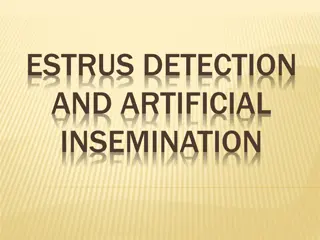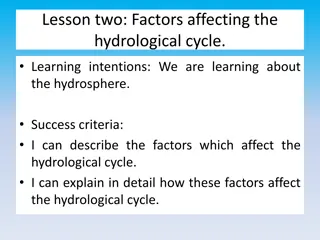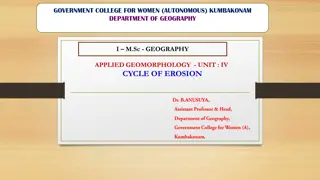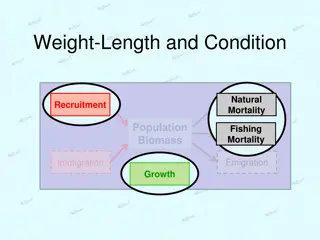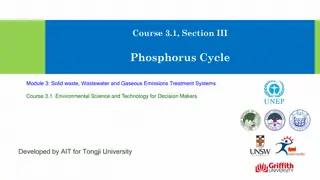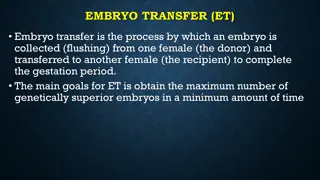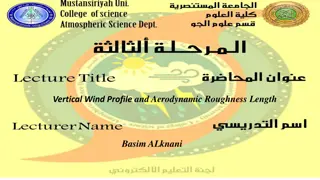Understanding Factors Influencing Estrus Cycle Length in Veterinary Science
Factors affecting the length of estrus cycle in animals, such as luteolysis, endocrine control, release of PGF2, and hormonal regulation, play crucial roles in determining the cyclicity and fertility of female animals. This comprehensive study delves into the intricate mechanisms involved in estrus cycle regulation, including the influence of hormones like oxytocin, estradiol, and progesterone on luteolysis and conception success.
Download Presentation

Please find below an Image/Link to download the presentation.
The content on the website is provided AS IS for your information and personal use only. It may not be sold, licensed, or shared on other websites without obtaining consent from the author. Download presentation by click this link. If you encounter any issues during the download, it is possible that the publisher has removed the file from their server.
E N D
Presentation Transcript
Factors Affecting the Length of Estrus Cycle Dr. D. Sengupta Assistant Professor Department of Veterinary Gynaecology & Obstetrics Bihar Veterinary College, Patna- 14
Estrus Cyclicity: Following ovulation, the corpus luteum which forms subsequently in the ovary is removed to permit a new ovarian cycle to begin. In this way, after a relatively short interval of time, a further opportunity is provided for the female to conceive. Exception- Dog
Factors Governing the Length of Estrus Cyclicity Luteolysis and its Endocrine Control Length of Follicular Phase Endocrine Control of Tonic Center of Hypothalamus for GnRH Release Pregnancy and Conception Failure
Luteolysis and its Endocrine Control Luteolysis is the physiological apoptosis of the corpus luteum In ruminants and swine this is mediated by Prostaglandin F2 (PGF2 )
Pulsatile release of PGF2 from the endometrium reaches the ovary by Utero-Ovarian Counter-Current Mechanism Exception Mare! In mares the uterine PGF2 is released in the blood and travels to the corpus luteum through general circulation endocrine manner. But the CL is much more efficient in capturing the PGF2 . i.e.
Endocrine Control of PGF2Release Oxytocin binds to its receptors in the plasma membrane and releases PGF2 Estradiol up-regulates OTRs and PRs Progesterone down-regulates ERs and OTRs and PRs after a length of ten days exposure PRs progressively decrease along the length of di-estrus IFN tau down-regulates ERs, PRs and OTRs thus blocks PGF2 release and abrogates luteolysis
Endocrine Control of PGF2Release Length of diestrus Length of Progesterone Exposure Up-regulations of hypothalamic and endometrial ERs Down-regulation of PRs Up-regulation of endometrial OTRs and increased release of oxytocin from hypothalamic nuclei Pulsatile Release of PGF2 Progression of folliculogenesis to Graafian Follicle Luteolysis ESTRUS
Timing of Onset of Pulsatile PGF2 release in farm animals Species Day of Onset of Pulsatile Release of Endometrial PGF2 Cattle 17 Sheep 13 Goat 18 Pig 14-15 Mare 15
Length of Follicular Phase Species Variation: Length of follicular phase is only 2 to 3 days in ewes but 3 to 5 days in bovines Individual Variation: Over-Sensitivity of Tonic Hypothalamic GnRH release center- Prolonged Follicular Phase Estradiol from the growing follicles reduces the LH pulse frequency and delays folliculogenesis
Endocrine Control of Tonic Center of Hypothalamus for GnRH Release High Cortisol Level (Heat Stress)- Decreases LH pulse frequency and delays ovulation High Melatonin Level (Photoperiodism)- Dark Hormone Melatonin increases/decreases GnRH release
Schematic depiction of the pattern of secretion of follicle-stimulating hormone (FSH; blue line), luteinizing hormone (LH; green lines), and progesterone (P4; orange line); and the pattern of growth of ovarian follicles during the estrous cycle in cattle. Each wave of follicular growth is preceded by a transient rise in FSH concentrations. Healthy growing follicles are shaded in yellow, atretic follicles are shaded red. A surge in LH and FSH concentrations occurs at the onset of estrus and induces ovulation. The pattern of secretion of LH pulses during an 8-h window early in the luteal phase (greater frequency, lesser amplitude), the mid-luteal phase (lesser frequency, lesser amplitude) and the follicular phase (high frequency, building to the surge) is indicated in the inserts in the top panel.
Seasonality/Photoperiod: Summary of the neuroendocrine integration of environmental signals and internal signals to control reproduction. The neuroendocrine integration of environmental signals, such as photoperiods and stress, and internal signals, such as GnIH, melatonin, and glucocorticoids, is important for the control of avian and mammalian reproduction. GnIH inhibits gonadotropin synthesis and release by directly acting on the pituitary or by inhibiting the activity of GnRH neurons in birds and mammals. GnIH can also inhibit reproductive behavior by possibly acting within the brain. GnIH expression is photoperiodically modulated via a melatonin-dependent process. Melatonin induces the expression of GnIH in quail and rats, whereas melatonin inhibits the expression of GnIH in hamsters and sheep. Stress induces the expression of GnIH in birds and mammals. GnIH may therefore be a mediator of stress-induced reproductive disruption.
Early Embryonic Death/Conception Failure Embryonic death before MRP does not affect the cycle length Embryonic death after MRP often leads to extension of cycle length This is mediated by Interferon tau released by the trophoblast that extends the luteal lifespan




